Corporate Finance Analysis Report
VerifiedAdded on 2020/02/05
|12
|2981
|114
Report
AI Summary
The report evaluates the investment project of Genetic Plc in genetically developed mustard seeds using capital budgeting techniques such as NPV, IRR, and payback period analysis. It provides recommendations to the Board of Directors based on the financial viability of the project, highlighting the importance of NPV over IRR in investment decisions. The report includes detailed calculations and a comprehensive analysis of cash inflows, costs, and the overall financial implications of the proposed investment.

CORPORATE
FINANCE
FINANCE
Paraphrase This Document
Need a fresh take? Get an instant paraphrase of this document with our AI Paraphraser
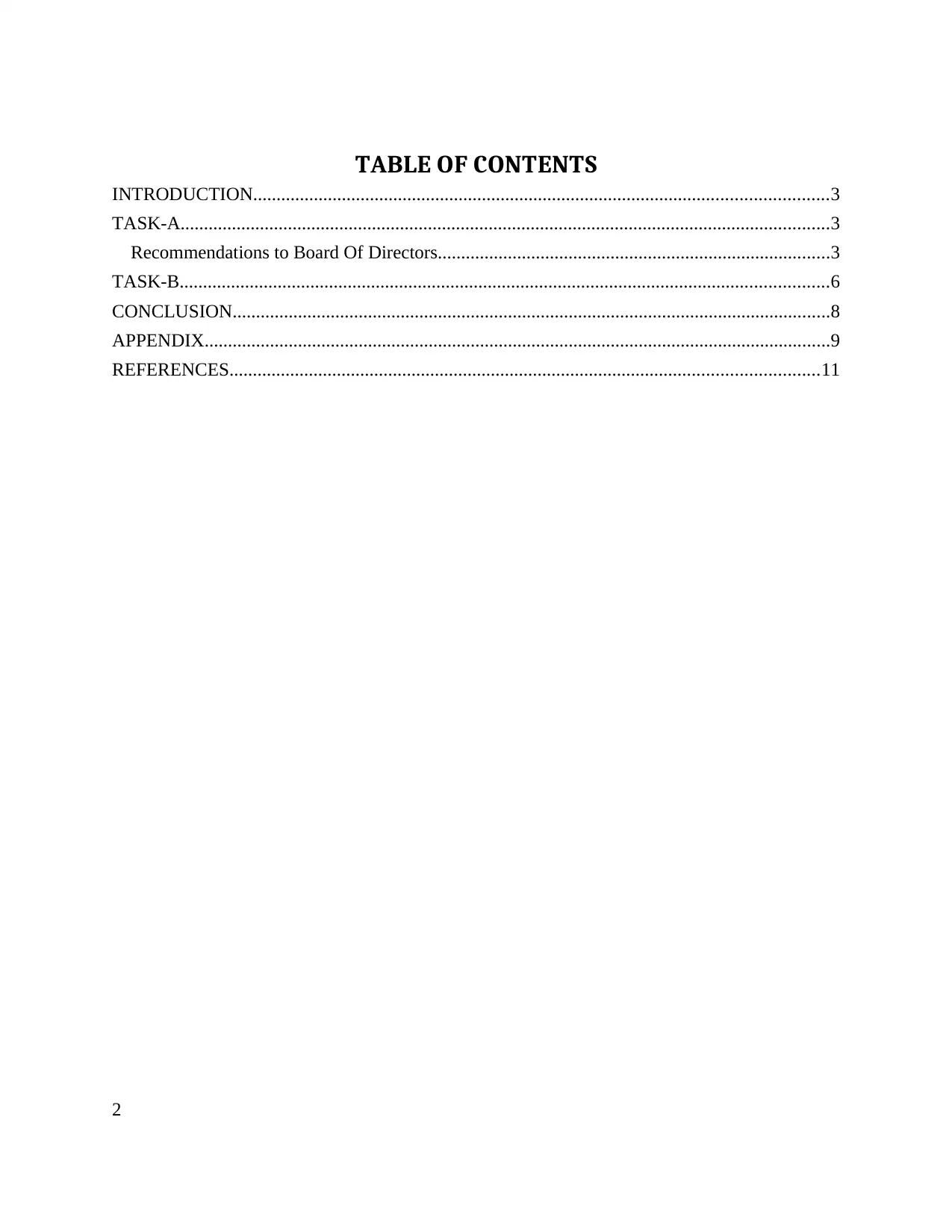
TABLE OF CONTENTS
INTRODUCTION...........................................................................................................................3
TASK-A...........................................................................................................................................3
Recommendations to Board Of Directors....................................................................................3
TASK-B...........................................................................................................................................6
CONCLUSION................................................................................................................................8
APPENDIX......................................................................................................................................9
REFERENCES..............................................................................................................................11
2
INTRODUCTION...........................................................................................................................3
TASK-A...........................................................................................................................................3
Recommendations to Board Of Directors....................................................................................3
TASK-B...........................................................................................................................................6
CONCLUSION................................................................................................................................8
APPENDIX......................................................................................................................................9
REFERENCES..............................................................................................................................11
2
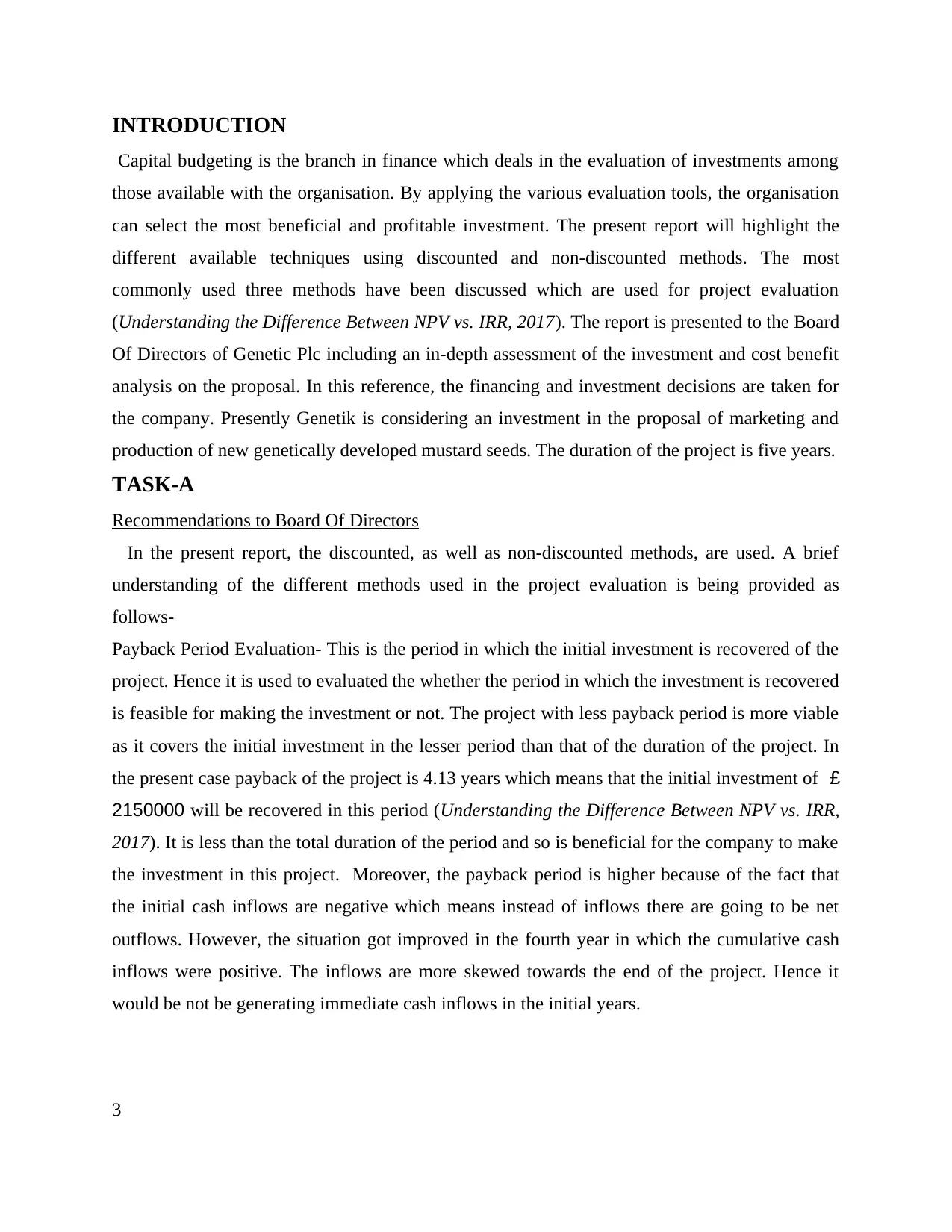
INTRODUCTION
Capital budgeting is the branch in finance which deals in the evaluation of investments among
those available with the organisation. By applying the various evaluation tools, the organisation
can select the most beneficial and profitable investment. The present report will highlight the
different available techniques using discounted and non-discounted methods. The most
commonly used three methods have been discussed which are used for project evaluation
(Understanding the Difference Between NPV vs. IRR, 2017). The report is presented to the Board
Of Directors of Genetic Plc including an in-depth assessment of the investment and cost benefit
analysis on the proposal. In this reference, the financing and investment decisions are taken for
the company. Presently Genetik is considering an investment in the proposal of marketing and
production of new genetically developed mustard seeds. The duration of the project is five years.
TASK-A
Recommendations to Board Of Directors
In the present report, the discounted, as well as non-discounted methods, are used. A brief
understanding of the different methods used in the project evaluation is being provided as
follows-
Payback Period Evaluation- This is the period in which the initial investment is recovered of the
project. Hence it is used to evaluated the whether the period in which the investment is recovered
is feasible for making the investment or not. The project with less payback period is more viable
as it covers the initial investment in the lesser period than that of the duration of the project. In
the present case payback of the project is 4.13 years which means that the initial investment of £
2150000 will be recovered in this period (Understanding the Difference Between NPV vs. IRR,
2017). It is less than the total duration of the period and so is beneficial for the company to make
the investment in this project. Moreover, the payback period is higher because of the fact that
the initial cash inflows are negative which means instead of inflows there are going to be net
outflows. However, the situation got improved in the fourth year in which the cumulative cash
inflows were positive. The inflows are more skewed towards the end of the project. Hence it
would be not be generating immediate cash inflows in the initial years.
3
Capital budgeting is the branch in finance which deals in the evaluation of investments among
those available with the organisation. By applying the various evaluation tools, the organisation
can select the most beneficial and profitable investment. The present report will highlight the
different available techniques using discounted and non-discounted methods. The most
commonly used three methods have been discussed which are used for project evaluation
(Understanding the Difference Between NPV vs. IRR, 2017). The report is presented to the Board
Of Directors of Genetic Plc including an in-depth assessment of the investment and cost benefit
analysis on the proposal. In this reference, the financing and investment decisions are taken for
the company. Presently Genetik is considering an investment in the proposal of marketing and
production of new genetically developed mustard seeds. The duration of the project is five years.
TASK-A
Recommendations to Board Of Directors
In the present report, the discounted, as well as non-discounted methods, are used. A brief
understanding of the different methods used in the project evaluation is being provided as
follows-
Payback Period Evaluation- This is the period in which the initial investment is recovered of the
project. Hence it is used to evaluated the whether the period in which the investment is recovered
is feasible for making the investment or not. The project with less payback period is more viable
as it covers the initial investment in the lesser period than that of the duration of the project. In
the present case payback of the project is 4.13 years which means that the initial investment of £
2150000 will be recovered in this period (Understanding the Difference Between NPV vs. IRR,
2017). It is less than the total duration of the period and so is beneficial for the company to make
the investment in this project. Moreover, the payback period is higher because of the fact that
the initial cash inflows are negative which means instead of inflows there are going to be net
outflows. However, the situation got improved in the fourth year in which the cumulative cash
inflows were positive. The inflows are more skewed towards the end of the project. Hence it
would be not be generating immediate cash inflows in the initial years.
3
⊘ This is a preview!⊘
Do you want full access?
Subscribe today to unlock all pages.

Trusted by 1+ million students worldwide
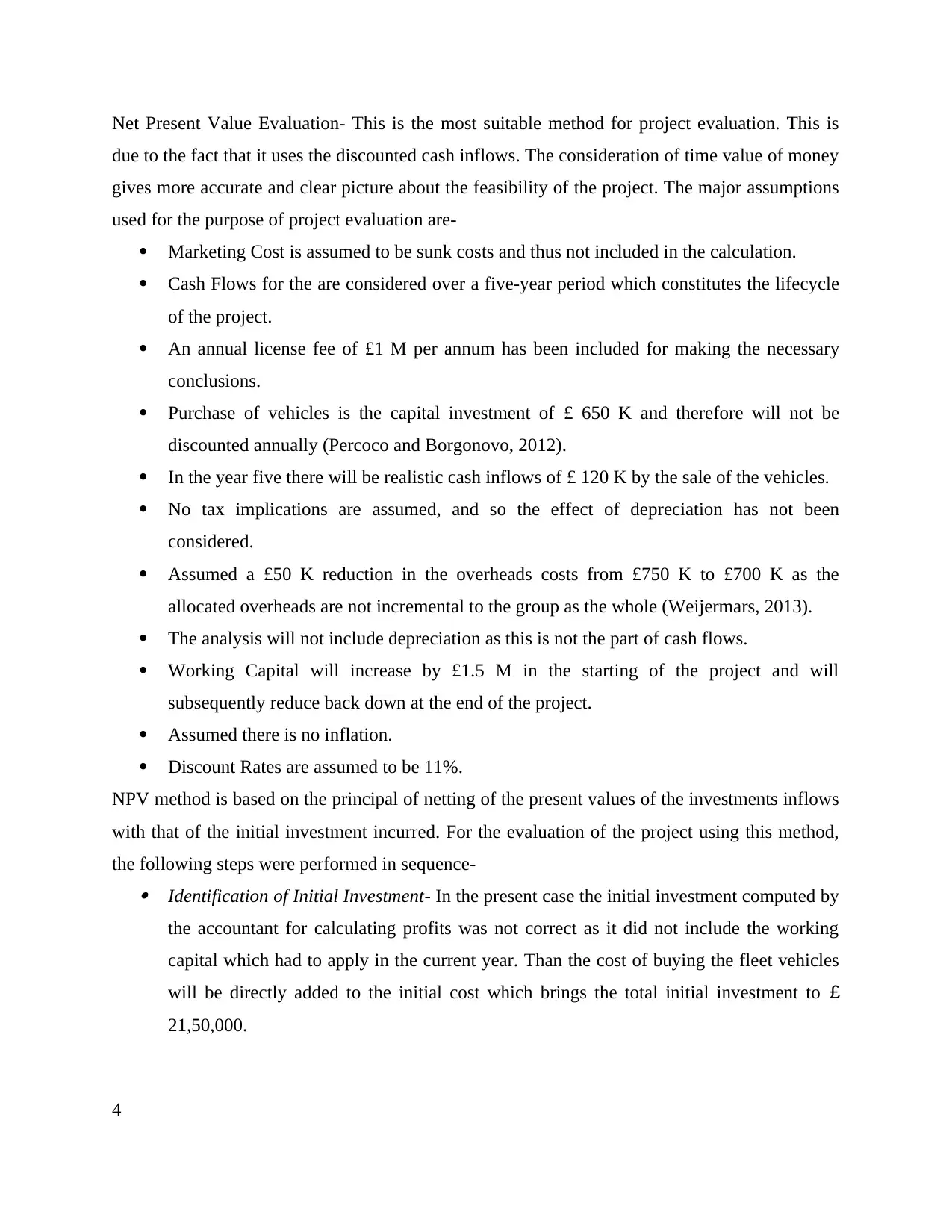
Net Present Value Evaluation- This is the most suitable method for project evaluation. This is
due to the fact that it uses the discounted cash inflows. The consideration of time value of money
gives more accurate and clear picture about the feasibility of the project. The major assumptions
used for the purpose of project evaluation are-
Marketing Cost is assumed to be sunk costs and thus not included in the calculation.
Cash Flows for the are considered over a five-year period which constitutes the lifecycle
of the project.
An annual license fee of £1 M per annum has been included for making the necessary
conclusions.
Purchase of vehicles is the capital investment of £ 650 K and therefore will not be
discounted annually (Percoco and Borgonovo, 2012).
In the year five there will be realistic cash inflows of £ 120 K by the sale of the vehicles.
No tax implications are assumed, and so the effect of depreciation has not been
considered.
Assumed a £50 K reduction in the overheads costs from £750 K to £700 K as the
allocated overheads are not incremental to the group as the whole (Weijermars, 2013).
The analysis will not include depreciation as this is not the part of cash flows.
Working Capital will increase by £1.5 M in the starting of the project and will
subsequently reduce back down at the end of the project.
Assumed there is no inflation.
Discount Rates are assumed to be 11%.
NPV method is based on the principal of netting of the present values of the investments inflows
with that of the initial investment incurred. For the evaluation of the project using this method,
the following steps were performed in sequence- Identification of Initial Investment- In the present case the initial investment computed by
the accountant for calculating profits was not correct as it did not include the working
capital which had to apply in the current year. Than the cost of buying the fleet vehicles
will be directly added to the initial cost which brings the total initial investment to £
21,50,000.
4
due to the fact that it uses the discounted cash inflows. The consideration of time value of money
gives more accurate and clear picture about the feasibility of the project. The major assumptions
used for the purpose of project evaluation are-
Marketing Cost is assumed to be sunk costs and thus not included in the calculation.
Cash Flows for the are considered over a five-year period which constitutes the lifecycle
of the project.
An annual license fee of £1 M per annum has been included for making the necessary
conclusions.
Purchase of vehicles is the capital investment of £ 650 K and therefore will not be
discounted annually (Percoco and Borgonovo, 2012).
In the year five there will be realistic cash inflows of £ 120 K by the sale of the vehicles.
No tax implications are assumed, and so the effect of depreciation has not been
considered.
Assumed a £50 K reduction in the overheads costs from £750 K to £700 K as the
allocated overheads are not incremental to the group as the whole (Weijermars, 2013).
The analysis will not include depreciation as this is not the part of cash flows.
Working Capital will increase by £1.5 M in the starting of the project and will
subsequently reduce back down at the end of the project.
Assumed there is no inflation.
Discount Rates are assumed to be 11%.
NPV method is based on the principal of netting of the present values of the investments inflows
with that of the initial investment incurred. For the evaluation of the project using this method,
the following steps were performed in sequence- Identification of Initial Investment- In the present case the initial investment computed by
the accountant for calculating profits was not correct as it did not include the working
capital which had to apply in the current year. Than the cost of buying the fleet vehicles
will be directly added to the initial cost which brings the total initial investment to £
21,50,000.
4
Paraphrase This Document
Need a fresh take? Get an instant paraphrase of this document with our AI Paraphraser
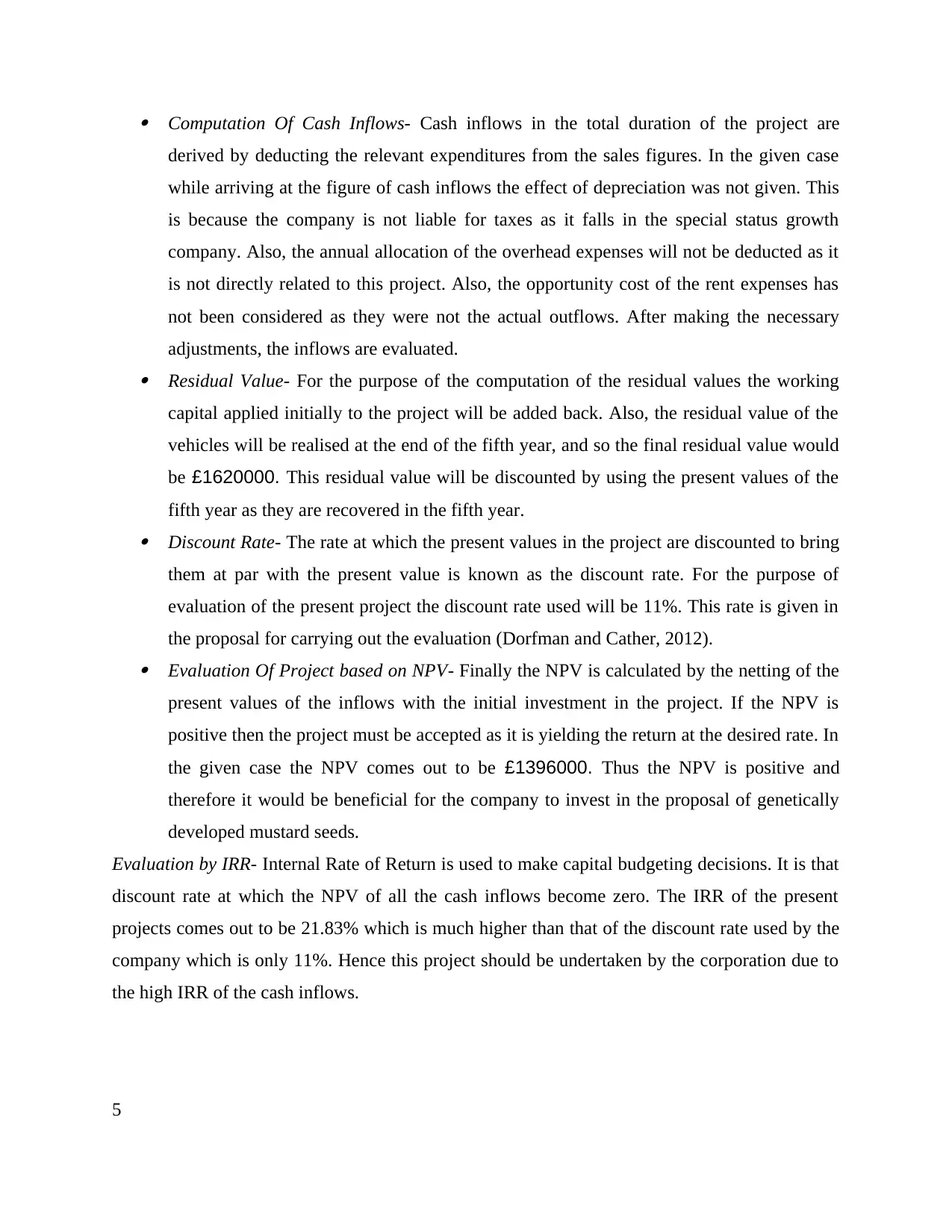
Computation Of Cash Inflows- Cash inflows in the total duration of the project are
derived by deducting the relevant expenditures from the sales figures. In the given case
while arriving at the figure of cash inflows the effect of depreciation was not given. This
is because the company is not liable for taxes as it falls in the special status growth
company. Also, the annual allocation of the overhead expenses will not be deducted as it
is not directly related to this project. Also, the opportunity cost of the rent expenses has
not been considered as they were not the actual outflows. After making the necessary
adjustments, the inflows are evaluated. Residual Value- For the purpose of the computation of the residual values the working
capital applied initially to the project will be added back. Also, the residual value of the
vehicles will be realised at the end of the fifth year, and so the final residual value would
be £1620000. This residual value will be discounted by using the present values of the
fifth year as they are recovered in the fifth year. Discount Rate- The rate at which the present values in the project are discounted to bring
them at par with the present value is known as the discount rate. For the purpose of
evaluation of the present project the discount rate used will be 11%. This rate is given in
the proposal for carrying out the evaluation (Dorfman and Cather, 2012). Evaluation Of Project based on NPV- Finally the NPV is calculated by the netting of the
present values of the inflows with the initial investment in the project. If the NPV is
positive then the project must be accepted as it is yielding the return at the desired rate. In
the given case the NPV comes out to be £1396000. Thus the NPV is positive and
therefore it would be beneficial for the company to invest in the proposal of genetically
developed mustard seeds.
Evaluation by IRR- Internal Rate of Return is used to make capital budgeting decisions. It is that
discount rate at which the NPV of all the cash inflows become zero. The IRR of the present
projects comes out to be 21.83% which is much higher than that of the discount rate used by the
company which is only 11%. Hence this project should be undertaken by the corporation due to
the high IRR of the cash inflows.
5
derived by deducting the relevant expenditures from the sales figures. In the given case
while arriving at the figure of cash inflows the effect of depreciation was not given. This
is because the company is not liable for taxes as it falls in the special status growth
company. Also, the annual allocation of the overhead expenses will not be deducted as it
is not directly related to this project. Also, the opportunity cost of the rent expenses has
not been considered as they were not the actual outflows. After making the necessary
adjustments, the inflows are evaluated. Residual Value- For the purpose of the computation of the residual values the working
capital applied initially to the project will be added back. Also, the residual value of the
vehicles will be realised at the end of the fifth year, and so the final residual value would
be £1620000. This residual value will be discounted by using the present values of the
fifth year as they are recovered in the fifth year. Discount Rate- The rate at which the present values in the project are discounted to bring
them at par with the present value is known as the discount rate. For the purpose of
evaluation of the present project the discount rate used will be 11%. This rate is given in
the proposal for carrying out the evaluation (Dorfman and Cather, 2012). Evaluation Of Project based on NPV- Finally the NPV is calculated by the netting of the
present values of the inflows with the initial investment in the project. If the NPV is
positive then the project must be accepted as it is yielding the return at the desired rate. In
the given case the NPV comes out to be £1396000. Thus the NPV is positive and
therefore it would be beneficial for the company to invest in the proposal of genetically
developed mustard seeds.
Evaluation by IRR- Internal Rate of Return is used to make capital budgeting decisions. It is that
discount rate at which the NPV of all the cash inflows become zero. The IRR of the present
projects comes out to be 21.83% which is much higher than that of the discount rate used by the
company which is only 11%. Hence this project should be undertaken by the corporation due to
the high IRR of the cash inflows.
5
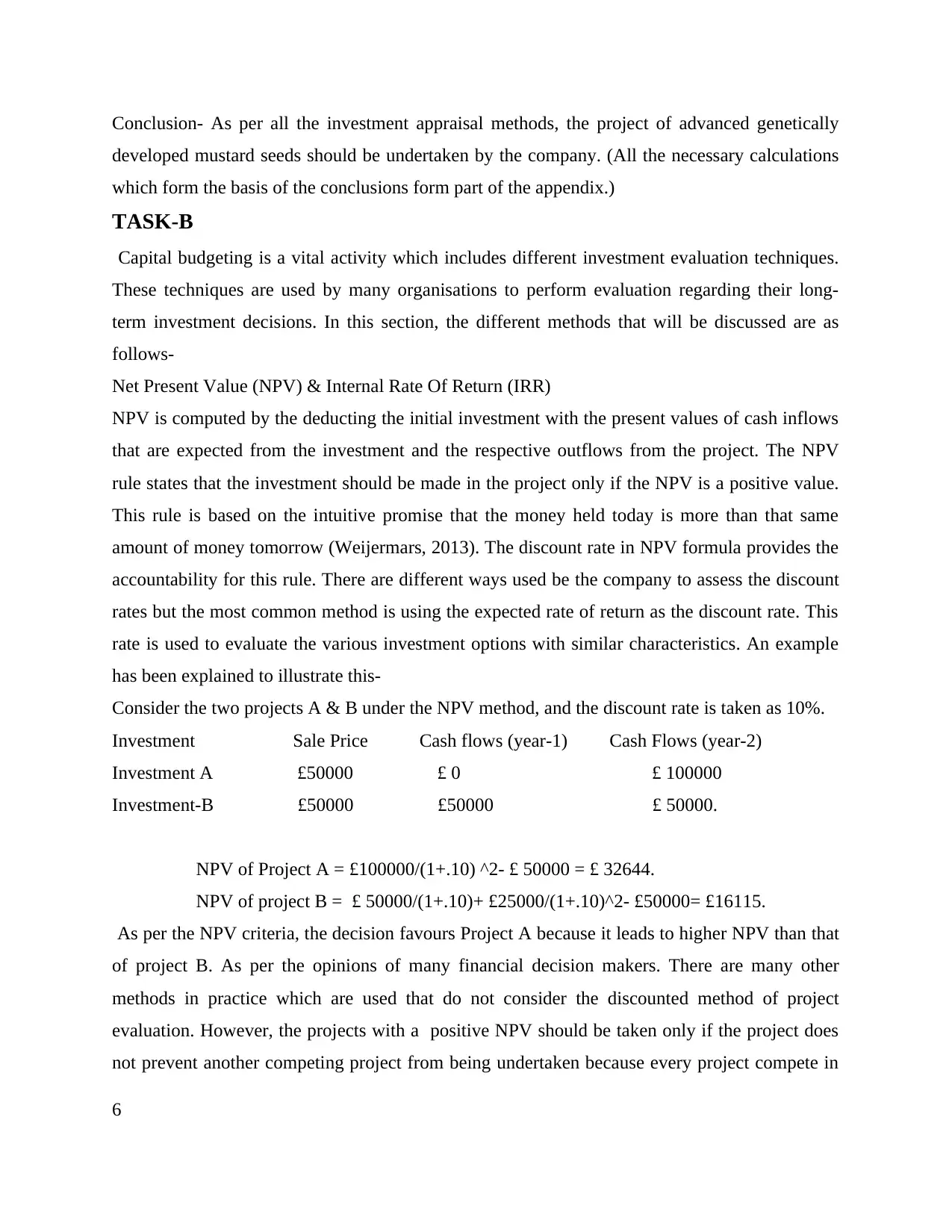
Conclusion- As per all the investment appraisal methods, the project of advanced genetically
developed mustard seeds should be undertaken by the company. (All the necessary calculations
which form the basis of the conclusions form part of the appendix.)
TASK-B
Capital budgeting is a vital activity which includes different investment evaluation techniques.
These techniques are used by many organisations to perform evaluation regarding their long-
term investment decisions. In this section, the different methods that will be discussed are as
follows-
Net Present Value (NPV) & Internal Rate Of Return (IRR)
NPV is computed by the deducting the initial investment with the present values of cash inflows
that are expected from the investment and the respective outflows from the project. The NPV
rule states that the investment should be made in the project only if the NPV is a positive value.
This rule is based on the intuitive promise that the money held today is more than that same
amount of money tomorrow (Weijermars, 2013). The discount rate in NPV formula provides the
accountability for this rule. There are different ways used be the company to assess the discount
rates but the most common method is using the expected rate of return as the discount rate. This
rate is used to evaluate the various investment options with similar characteristics. An example
has been explained to illustrate this-
Consider the two projects A & B under the NPV method, and the discount rate is taken as 10%.
Investment Sale Price Cash flows (year-1) Cash Flows (year-2)
Investment A £50000 £ 0 £ 100000
Investment-B £50000 £50000 £ 50000.
NPV of Project A = £100000/(1+.10) ^2- £ 50000 = £ 32644.
NPV of project B = £ 50000/(1+.10)+ £25000/(1+.10)^2- £50000= £16115.
As per the NPV criteria, the decision favours Project A because it leads to higher NPV than that
of project B. As per the opinions of many financial decision makers. There are many other
methods in practice which are used that do not consider the discounted method of project
evaluation. However, the projects with a positive NPV should be taken only if the project does
not prevent another competing project from being undertaken because every project compete in
6
developed mustard seeds should be undertaken by the company. (All the necessary calculations
which form the basis of the conclusions form part of the appendix.)
TASK-B
Capital budgeting is a vital activity which includes different investment evaluation techniques.
These techniques are used by many organisations to perform evaluation regarding their long-
term investment decisions. In this section, the different methods that will be discussed are as
follows-
Net Present Value (NPV) & Internal Rate Of Return (IRR)
NPV is computed by the deducting the initial investment with the present values of cash inflows
that are expected from the investment and the respective outflows from the project. The NPV
rule states that the investment should be made in the project only if the NPV is a positive value.
This rule is based on the intuitive promise that the money held today is more than that same
amount of money tomorrow (Weijermars, 2013). The discount rate in NPV formula provides the
accountability for this rule. There are different ways used be the company to assess the discount
rates but the most common method is using the expected rate of return as the discount rate. This
rate is used to evaluate the various investment options with similar characteristics. An example
has been explained to illustrate this-
Consider the two projects A & B under the NPV method, and the discount rate is taken as 10%.
Investment Sale Price Cash flows (year-1) Cash Flows (year-2)
Investment A £50000 £ 0 £ 100000
Investment-B £50000 £50000 £ 50000.
NPV of Project A = £100000/(1+.10) ^2- £ 50000 = £ 32644.
NPV of project B = £ 50000/(1+.10)+ £25000/(1+.10)^2- £50000= £16115.
As per the NPV criteria, the decision favours Project A because it leads to higher NPV than that
of project B. As per the opinions of many financial decision makers. There are many other
methods in practice which are used that do not consider the discounted method of project
evaluation. However, the projects with a positive NPV should be taken only if the project does
not prevent another competing project from being undertaken because every project compete in
6
⊘ This is a preview!⊘
Do you want full access?
Subscribe today to unlock all pages.

Trusted by 1+ million students worldwide
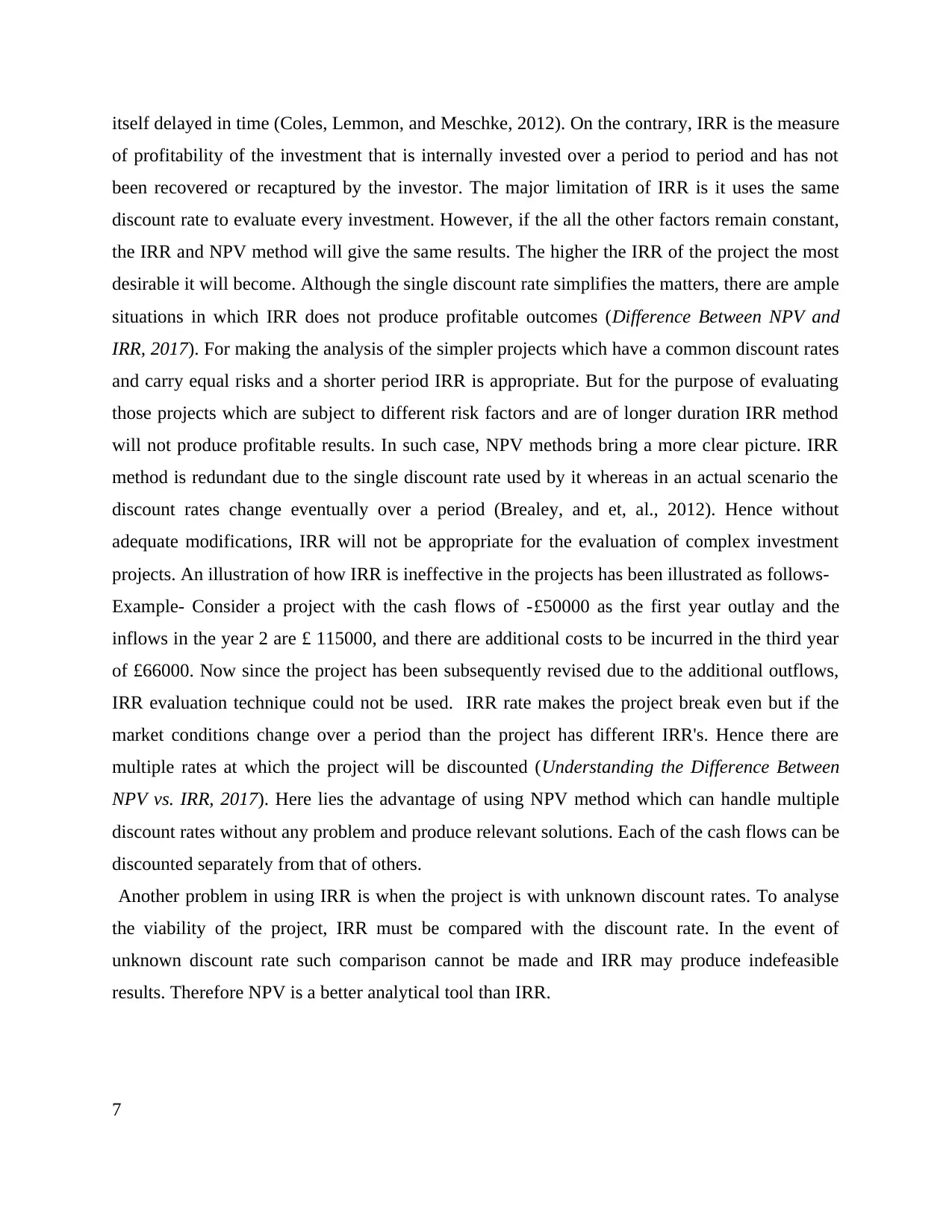
itself delayed in time (Coles, Lemmon, and Meschke, 2012). On the contrary, IRR is the measure
of profitability of the investment that is internally invested over a period to period and has not
been recovered or recaptured by the investor. The major limitation of IRR is it uses the same
discount rate to evaluate every investment. However, if the all the other factors remain constant,
the IRR and NPV method will give the same results. The higher the IRR of the project the most
desirable it will become. Although the single discount rate simplifies the matters, there are ample
situations in which IRR does not produce profitable outcomes (Difference Between NPV and
IRR, 2017). For making the analysis of the simpler projects which have a common discount rates
and carry equal risks and a shorter period IRR is appropriate. But for the purpose of evaluating
those projects which are subject to different risk factors and are of longer duration IRR method
will not produce profitable results. In such case, NPV methods bring a more clear picture. IRR
method is redundant due to the single discount rate used by it whereas in an actual scenario the
discount rates change eventually over a period (Brealey, and et, al., 2012). Hence without
adequate modifications, IRR will not be appropriate for the evaluation of complex investment
projects. An illustration of how IRR is ineffective in the projects has been illustrated as follows-
Example- Consider a project with the cash flows of -£50000 as the first year outlay and the
inflows in the year 2 are £ 115000, and there are additional costs to be incurred in the third year
of £66000. Now since the project has been subsequently revised due to the additional outflows,
IRR evaluation technique could not be used. IRR rate makes the project break even but if the
market conditions change over a period than the project has different IRR's. Hence there are
multiple rates at which the project will be discounted (Understanding the Difference Between
NPV vs. IRR, 2017). Here lies the advantage of using NPV method which can handle multiple
discount rates without any problem and produce relevant solutions. Each of the cash flows can be
discounted separately from that of others.
Another problem in using IRR is when the project is with unknown discount rates. To analyse
the viability of the project, IRR must be compared with the discount rate. In the event of
unknown discount rate such comparison cannot be made and IRR may produce indefeasible
results. Therefore NPV is a better analytical tool than IRR.
7
of profitability of the investment that is internally invested over a period to period and has not
been recovered or recaptured by the investor. The major limitation of IRR is it uses the same
discount rate to evaluate every investment. However, if the all the other factors remain constant,
the IRR and NPV method will give the same results. The higher the IRR of the project the most
desirable it will become. Although the single discount rate simplifies the matters, there are ample
situations in which IRR does not produce profitable outcomes (Difference Between NPV and
IRR, 2017). For making the analysis of the simpler projects which have a common discount rates
and carry equal risks and a shorter period IRR is appropriate. But for the purpose of evaluating
those projects which are subject to different risk factors and are of longer duration IRR method
will not produce profitable results. In such case, NPV methods bring a more clear picture. IRR
method is redundant due to the single discount rate used by it whereas in an actual scenario the
discount rates change eventually over a period (Brealey, and et, al., 2012). Hence without
adequate modifications, IRR will not be appropriate for the evaluation of complex investment
projects. An illustration of how IRR is ineffective in the projects has been illustrated as follows-
Example- Consider a project with the cash flows of -£50000 as the first year outlay and the
inflows in the year 2 are £ 115000, and there are additional costs to be incurred in the third year
of £66000. Now since the project has been subsequently revised due to the additional outflows,
IRR evaluation technique could not be used. IRR rate makes the project break even but if the
market conditions change over a period than the project has different IRR's. Hence there are
multiple rates at which the project will be discounted (Understanding the Difference Between
NPV vs. IRR, 2017). Here lies the advantage of using NPV method which can handle multiple
discount rates without any problem and produce relevant solutions. Each of the cash flows can be
discounted separately from that of others.
Another problem in using IRR is when the project is with unknown discount rates. To analyse
the viability of the project, IRR must be compared with the discount rate. In the event of
unknown discount rate such comparison cannot be made and IRR may produce indefeasible
results. Therefore NPV is a better analytical tool than IRR.
7
Paraphrase This Document
Need a fresh take? Get an instant paraphrase of this document with our AI Paraphraser

CONCLUSION
The present report evaluates the project of producing and marketing the genetically
developed mustard seeds by Genetic Plc. Payback, NPV and IRR methods are used to reach a
reasonable conclusion of undertaking the investment project. Section B covers the importance of
using NPV over IRR method along with some supporting illustrations.
8
The present report evaluates the project of producing and marketing the genetically
developed mustard seeds by Genetic Plc. Payback, NPV and IRR methods are used to reach a
reasonable conclusion of undertaking the investment project. Section B covers the importance of
using NPV over IRR method along with some supporting illustrations.
8
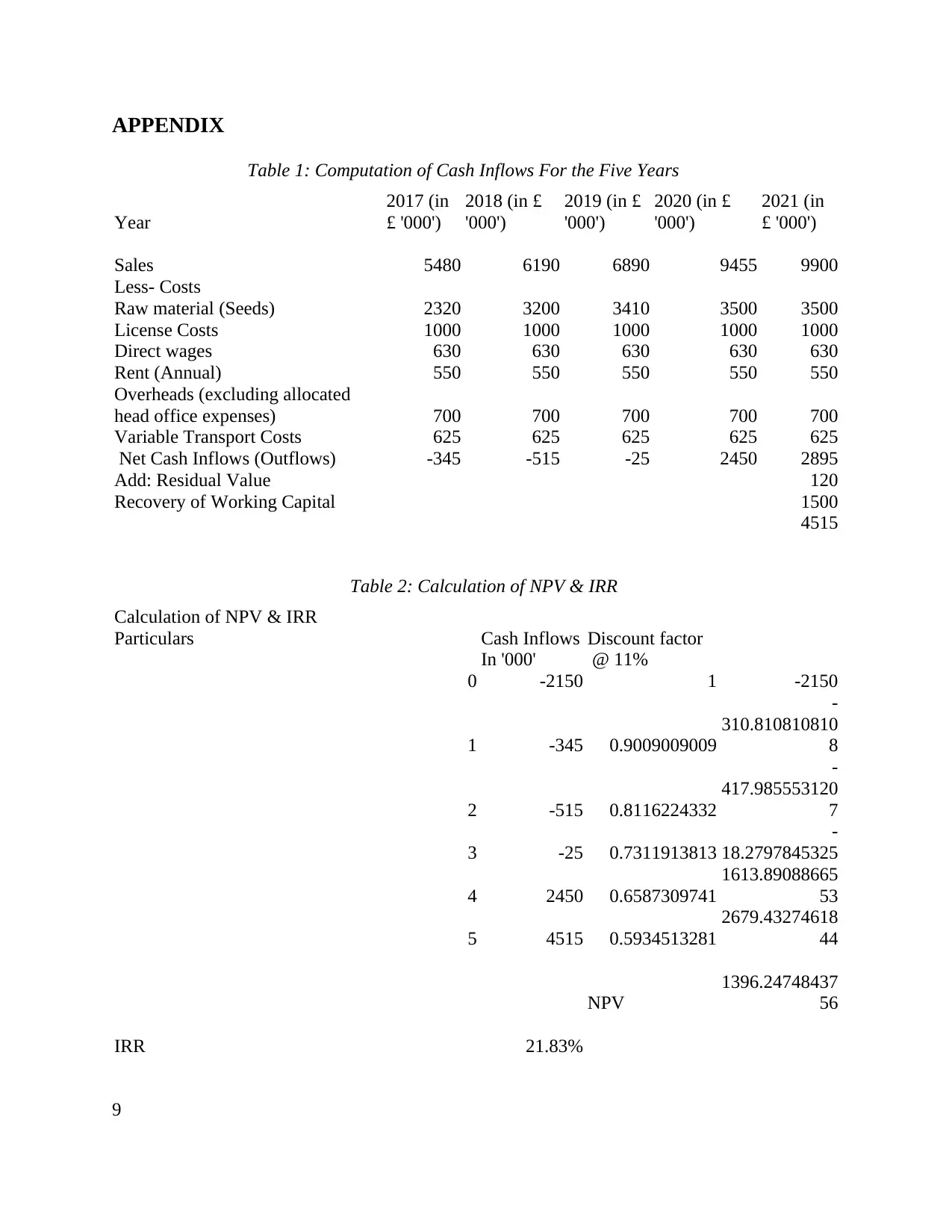
APPENDIX
Table 1: Computation of Cash Inflows For the Five Years
Year
2017 (in
£ '000')
2018 (in £
'000')
2019 (in £
'000')
2020 (in £
'000')
2021 (in
£ '000')
Sales 5480 6190 6890 9455 9900
Less- Costs
Raw material (Seeds) 2320 3200 3410 3500 3500
License Costs 1000 1000 1000 1000 1000
Direct wages 630 630 630 630 630
Rent (Annual) 550 550 550 550 550
Overheads (excluding allocated
head office expenses) 700 700 700 700 700
Variable Transport Costs 625 625 625 625 625
Net Cash Inflows (Outflows) -345 -515 -25 2450 2895
Add: Residual Value 120
Recovery of Working Capital 1500
4515
Table 2: Calculation of NPV & IRR
Calculation of NPV & IRR
Particulars Cash Inflows Discount factor
In '000' @ 11%
0 -2150 1 -2150
1 -345 0.9009009009
-
310.810810810
8
2 -515 0.8116224332
-
417.985553120
7
3 -25 0.7311913813
-
18.2797845325
4 2450 0.6587309741
1613.89088665
53
5 4515 0.5934513281
2679.43274618
44
NPV
1396.24748437
56
IRR 21.83%
9
Table 1: Computation of Cash Inflows For the Five Years
Year
2017 (in
£ '000')
2018 (in £
'000')
2019 (in £
'000')
2020 (in £
'000')
2021 (in
£ '000')
Sales 5480 6190 6890 9455 9900
Less- Costs
Raw material (Seeds) 2320 3200 3410 3500 3500
License Costs 1000 1000 1000 1000 1000
Direct wages 630 630 630 630 630
Rent (Annual) 550 550 550 550 550
Overheads (excluding allocated
head office expenses) 700 700 700 700 700
Variable Transport Costs 625 625 625 625 625
Net Cash Inflows (Outflows) -345 -515 -25 2450 2895
Add: Residual Value 120
Recovery of Working Capital 1500
4515
Table 2: Calculation of NPV & IRR
Calculation of NPV & IRR
Particulars Cash Inflows Discount factor
In '000' @ 11%
0 -2150 1 -2150
1 -345 0.9009009009
-
310.810810810
8
2 -515 0.8116224332
-
417.985553120
7
3 -25 0.7311913813
-
18.2797845325
4 2450 0.6587309741
1613.89088665
53
5 4515 0.5934513281
2679.43274618
44
NPV
1396.24748437
56
IRR 21.83%
9
⊘ This is a preview!⊘
Do you want full access?
Subscribe today to unlock all pages.

Trusted by 1+ million students worldwide
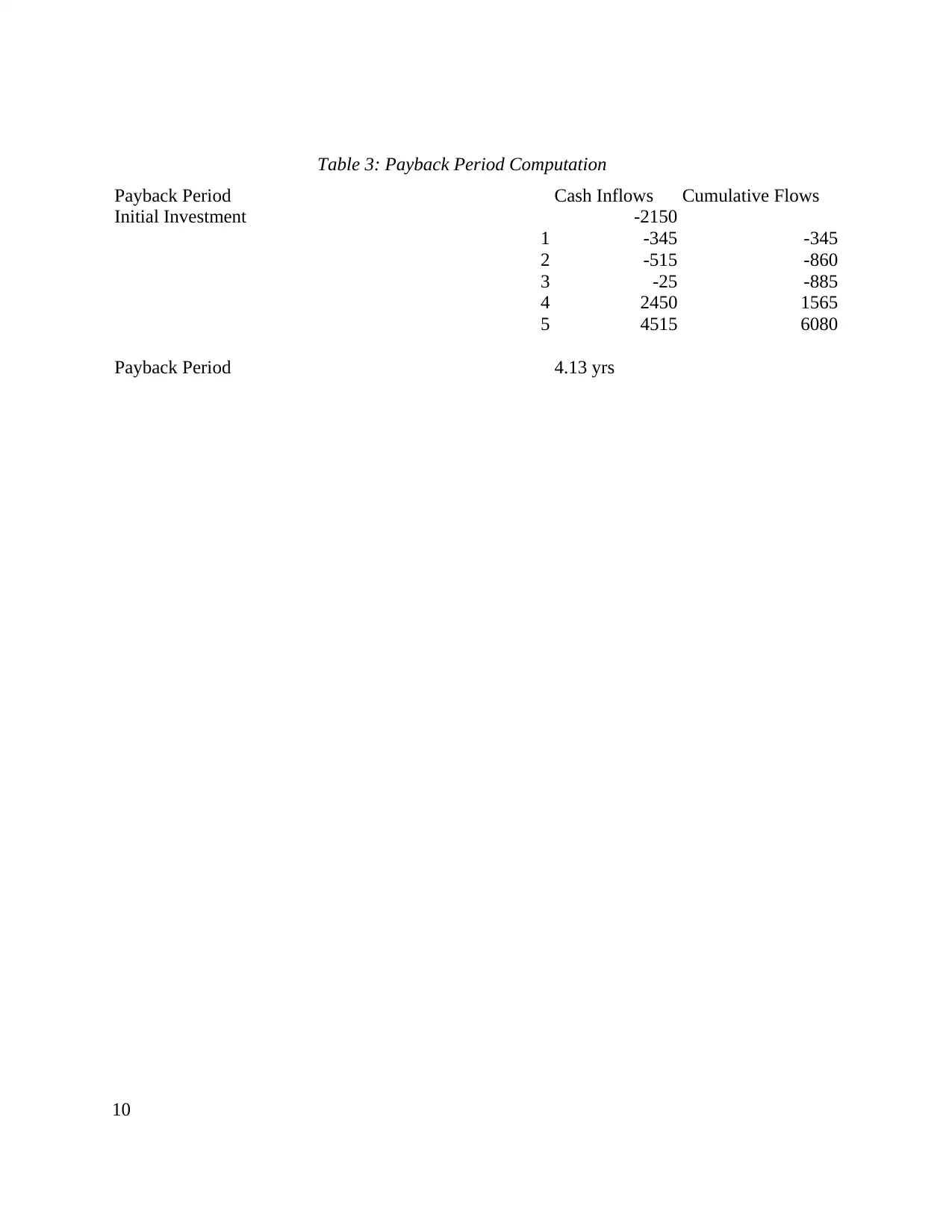
Table 3: Payback Period Computation
Payback Period Cash Inflows Cumulative Flows
Initial Investment -2150
1 -345 -345
2 -515 -860
3 -25 -885
4 2450 1565
5 4515 6080
Payback Period 4.13 yrs
10
Payback Period Cash Inflows Cumulative Flows
Initial Investment -2150
1 -345 -345
2 -515 -860
3 -25 -885
4 2450 1565
5 4515 6080
Payback Period 4.13 yrs
10
Paraphrase This Document
Need a fresh take? Get an instant paraphrase of this document with our AI Paraphraser
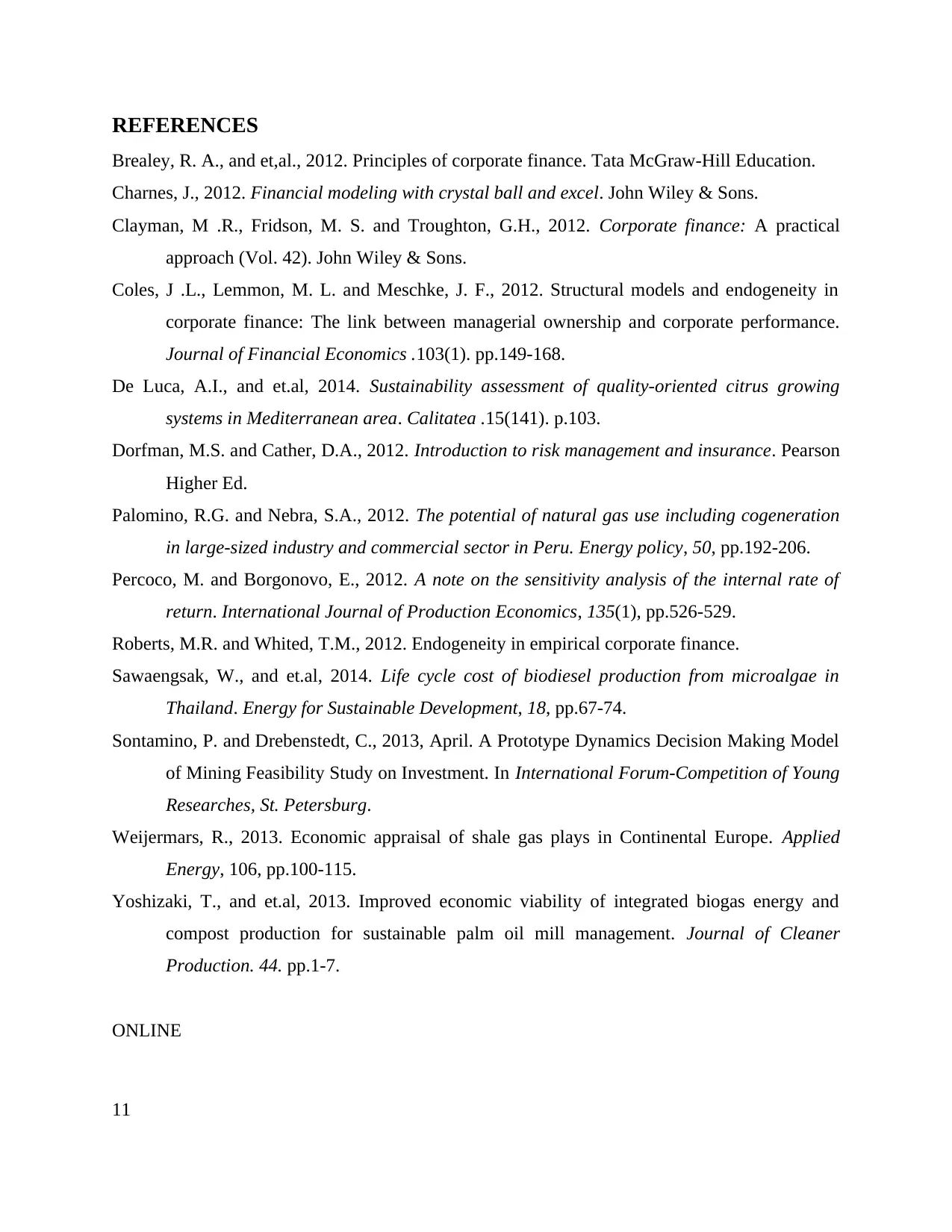
REFERENCES
Brealey, R. A., and et,al., 2012. Principles of corporate finance. Tata McGraw-Hill Education.
Charnes, J., 2012. Financial modeling with crystal ball and excel. John Wiley & Sons.
Clayman, M .R., Fridson, M. S. and Troughton, G.H., 2012. Corporate finance: A practical
approach (Vol. 42). John Wiley & Sons.
Coles, J .L., Lemmon, M. L. and Meschke, J. F., 2012. Structural models and endogeneity in
corporate finance: The link between managerial ownership and corporate performance.
Journal of Financial Economics .103(1). pp.149-168.
De Luca, A.I., and et.al, 2014. Sustainability assessment of quality-oriented citrus growing
systems in Mediterranean area. Calitatea .15(141). p.103.
Dorfman, M.S. and Cather, D.A., 2012. Introduction to risk management and insurance. Pearson
Higher Ed.
Palomino, R.G. and Nebra, S.A., 2012. The potential of natural gas use including cogeneration
in large-sized industry and commercial sector in Peru. Energy policy, 50, pp.192-206.
Percoco, M. and Borgonovo, E., 2012. A note on the sensitivity analysis of the internal rate of
return. International Journal of Production Economics, 135(1), pp.526-529.
Roberts, M.R. and Whited, T.M., 2012. Endogeneity in empirical corporate finance.
Sawaengsak, W., and et.al, 2014. Life cycle cost of biodiesel production from microalgae in
Thailand. Energy for Sustainable Development, 18, pp.67-74.
Sontamino, P. and Drebenstedt, C., 2013, April. A Prototype Dynamics Decision Making Model
of Mining Feasibility Study on Investment. In International Forum-Competition of Young
Researches, St. Petersburg.
Weijermars, R., 2013. Economic appraisal of shale gas plays in Continental Europe. Applied
Energy, 106, pp.100-115.
Yoshizaki, T., and et.al, 2013. Improved economic viability of integrated biogas energy and
compost production for sustainable palm oil mill management. Journal of Cleaner
Production. 44. pp.1-7.
ONLINE
11
Brealey, R. A., and et,al., 2012. Principles of corporate finance. Tata McGraw-Hill Education.
Charnes, J., 2012. Financial modeling with crystal ball and excel. John Wiley & Sons.
Clayman, M .R., Fridson, M. S. and Troughton, G.H., 2012. Corporate finance: A practical
approach (Vol. 42). John Wiley & Sons.
Coles, J .L., Lemmon, M. L. and Meschke, J. F., 2012. Structural models and endogeneity in
corporate finance: The link between managerial ownership and corporate performance.
Journal of Financial Economics .103(1). pp.149-168.
De Luca, A.I., and et.al, 2014. Sustainability assessment of quality-oriented citrus growing
systems in Mediterranean area. Calitatea .15(141). p.103.
Dorfman, M.S. and Cather, D.A., 2012. Introduction to risk management and insurance. Pearson
Higher Ed.
Palomino, R.G. and Nebra, S.A., 2012. The potential of natural gas use including cogeneration
in large-sized industry and commercial sector in Peru. Energy policy, 50, pp.192-206.
Percoco, M. and Borgonovo, E., 2012. A note on the sensitivity analysis of the internal rate of
return. International Journal of Production Economics, 135(1), pp.526-529.
Roberts, M.R. and Whited, T.M., 2012. Endogeneity in empirical corporate finance.
Sawaengsak, W., and et.al, 2014. Life cycle cost of biodiesel production from microalgae in
Thailand. Energy for Sustainable Development, 18, pp.67-74.
Sontamino, P. and Drebenstedt, C., 2013, April. A Prototype Dynamics Decision Making Model
of Mining Feasibility Study on Investment. In International Forum-Competition of Young
Researches, St. Petersburg.
Weijermars, R., 2013. Economic appraisal of shale gas plays in Continental Europe. Applied
Energy, 106, pp.100-115.
Yoshizaki, T., and et.al, 2013. Improved economic viability of integrated biogas energy and
compost production for sustainable palm oil mill management. Journal of Cleaner
Production. 44. pp.1-7.
ONLINE
11

Difference Between NPV and IRR, 2017. Avaliable
through<http://keydifferences.com/difference-between-npv-and-irr.html> Assessed on 07th
January 2016.
Understanding the Difference Between NPV vs IRR, 2017.Avaliable
through<http://www.propertymetrics.com/blog/2013/06/28/npv-vs-irr/> Assessed on 07th
January 2016.
12
through<http://keydifferences.com/difference-between-npv-and-irr.html> Assessed on 07th
January 2016.
Understanding the Difference Between NPV vs IRR, 2017.Avaliable
through<http://www.propertymetrics.com/blog/2013/06/28/npv-vs-irr/> Assessed on 07th
January 2016.
12
⊘ This is a preview!⊘
Do you want full access?
Subscribe today to unlock all pages.

Trusted by 1+ million students worldwide
1 out of 12
Related Documents
Your All-in-One AI-Powered Toolkit for Academic Success.
+13062052269
info@desklib.com
Available 24*7 on WhatsApp / Email
![[object Object]](/_next/static/media/star-bottom.7253800d.svg)
Unlock your academic potential
Copyright © 2020–2025 A2Z Services. All Rights Reserved. Developed and managed by ZUCOL.





